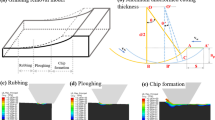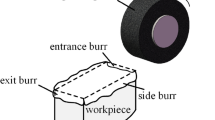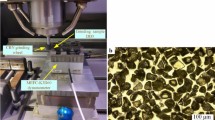Abstract
Nickel-based single crystal superalloys exhibit excellent mechanical properties that make them suitable for aviation and industrial steam turbine blades. However, due to their distinguished properties, processing such materials becomes challenging. In order to enhance the fatigue life of workpiece processing, this research involved the development of a three-dimensional Hill simulation model of a single abrasive grain based on the anisotropic parameters of materials. The study also explored the formation mechanisms of the subsurface metamorphic layer of nickel-based single crystal superalloy DD5. The influence of grinding process parameters, such as wheel speed (vs), grinding depth (ap), and feed rate (vf), on the subsurface metamorphic layer of the workpiece was comparatively analyzed. In addition, the influence of the grinding process parameters on the thickness of the metamorphic layer of the (001) crystal plane of the workpiece was examined. The low damage grinding parameters of DD5 were determined to be as follows: the linear speed of the wheel speed is 35 m/s, the grinding depth is 20 μm, and the feed rate is 0.2 m/min. Further, combining with experimental analysis, the influence of each grinding process parameter was analyzed, whereby the wheel speed was found to have the greatest influence on the metamorphic layer of the workpiece.

















Similar content being viewed by others
Data availability
All data and materials used to produce the results in this article can be obtained upon request from the corresponding authors.
Code availability
Not applicable.
References
Klocke F, Soo SL, Karpuschewski B, Webster JA, Novovic D, Elfizy A, Axinte DA, Tönissen S (2015) Abrasive machining of advanced aerospace alloys and composites. CIRP Ann-Manuf Technol 64(2):581–604. https://doi.org/10.1016/j.cirp.2015.05.004
Sun JY, Yang S, Yuan H (2021) Assessment of thermo-mechanical fatigue in a nickel-based single-crystal superalloy CMSX-4 accounting for temperature gradient effects. Mater Sci Eng A 809:140918. https://doi.org/10.1016/j.msea.2021.140918
Sun SY, Li L, Yue Z, Yang WF, Zhao ZN, Cao R, Li SW (2020) Experimental and numerical investigation on fretting fatigue behavior of nickel-based single crystal superalloy at high temperature. Mech Mater 150:103595. https://doi.org/10.1016/j.mechmat.2020.103595
Han QN, Qiu WH, He ZW, Su Y, Ma XF, Shi HJ (2018) The effect of crystal orientation on fretting fatigue crack formation in Ni-based single-crystal superalloys: In-situ SEM observation and crystal plasticity finite element simulation. Tribol Int 125:209–219. https://doi.org/10.1016/j.triboint.2018.01.011
Gong YD, Zhou YG, Wen XL, Cheng J, Sun Y, Ma LJ (2017) Experimental study on micro-grinding force and subsurface microstructure of nickel-based single crystal superalloy in micro grinding. J Mech Sci Technol 31:3397–3410. https://doi.org/10.1007/s12206-017-0629-8
Sun Y, Jin LY, Gong YD, Wen XL, Yin GQ, Wen Q, Tang BJ (2022) Experimental evaluation of surface generation and force time-varying characteristics of curvilinear grooved micro end mills fabricated by EDM. J Manuf Process 73:799–814. https://doi.org/10.1016/j.jmapro.2021.11.049
Qu SS, Yao P, Gong YD, Yang YY, Chu DK, Zhu QS (2022) Modelling and grinding characteristics of unidirectional C-SiCs. Ceram Int 48(6):8314–8324. https://doi.org/10.1016/j.ceramint.2021.12.036
Chen Z, Colliander MH, Sundell G, Peng RL, Zhou JM, Johansson S, Moverare J. Nano-scale characterization of white layer in broached Inconel 718. Mater Sci Eng A 684:373–84. https://doi.org/10.1016/j.msea.2016.12.045
Wang YS, Deng YS, Xiu SC (2018) Study on the dynamic recrystallization mechanism during pre-stress dry grinding. J Manuf Process 32:100–109. https://doi.org/10.1016/j.jmapro.2018.01.021
Zhang JH, Ge PQ, Zhang L, Yu Y, Li H (2010) Study on the friction and wear behavior of grind-hardened layer. Key Eng Mater 431–432:385–388. https://doi.org/10.4028/www.scientifc.net/KEM.431-432.385
Mishra VK, Salonitis K (2013) Empirical estimation of grinding specific forces and energy based on a modified Werner grinding model. Proc CIRP 8:287–292. https://doi.org/10.1016/j.procir.2013.06.104
Aslan D, Budak E (2014) Semi-analytical force model for grinding operations. Proc CIRP 14:7–12. https://doi.org/10.1016/j.procir.2014.03.073
Zhu T, Cai M, Gong YD, Gao XJ, Yu N, Gong Q (2023) Study on the chip formation in grinding of nickel-based single-crystal superalloy DD5. Int J Adv Manuf Technol 125:5781–5798. https://doi.org/10.1007/s00170-023-11096-8
Doman DA, Warkentin A, Bauer R (2009) Finite element modeling approaches in grinding. Int J Mach Tool Manu 49(2):109–116. https://doi.org/10.1016/j.ijmachtools.2008.10.002
Liu HG, Zhang J, Xu BB, Zhang HJ, Zhao WH (2021) Whole process analysis of microstructure evolution during chip formation of high-speed machining OFHC copper. J Manuf Process 66:470–482. https://doi.org/10.1016/j.jmapro.2021.04.038
Liu HG, Zhang J, Xu BB, Zhao WH (2020) Prediction of microstructure gradient distribution in machined surface induced by high speed machining through a coupled FE and CA approach. Mater Des 196:109133. https://doi.org/10.1016/j.matdes.2020.109133
Zahedi A, Azarhoushang B (2016) FEM based modeling of cylindrical grinding process incorporating wheel topography measurement. Proc CIRP 46:201–204. https://doi.org/10.1016/j.procir.2016.03.179
Tao HF, Liu YH, Zhao DW, Lu XC (2022) Undeformed chip width nonuniformity modeling and surface roughness prediction in wafer self-rotational grinding process. Tribol Int 171:107547. https://doi.org/10.1016/j.triboint.2022.107547
Liu MZ, Li CH, Zhang YB, Yang M, Gao T, Cui X, Wang XM, Li HN, Said Z, Li R, Sharma S (2023) Analysis of grain tribology and improved grinding temperature model based on discrete heat source. Tribol Int 18:108196. https://doi.org/10.1016/j.triboint.2022.108196
Ding WF, Xu JH, Chen ZZ, Su HH, Fu YC (2010) Grindability and surface integrity of cast nickel-based superalloy in creep feed grinding with brazed CBN abrasive wheels. Chin J Aeronaut 23(4):501–510. https://doi.org/10.1016/S1000-9361(09)60247-8
Curtis DT, Soo SL, Aspinwall DK, Mantle AL (2016) Evaluation of workpiece surface integrity following point grinding of advanced titanium and nickel based alloys. Proc CIRP 45:47–50. https://doi.org/10.1016/j.procir.2016.02.343
Liao ZR, Polyakov M, Diaz OG, Axinte D, Mohanty G, Maeder X, Michler J, Hardy M (2019) Grain refinement mechanism of nickel-based superalloy by severe plastic deformation - Mechanical machining case. Acta Mater 180:2–14. https://doi.org/10.1016/j.actamat.2019.08.059
Liu XC, Zhang HW, Lu K (2013) Strain-induced ultrahard and ultrastable nanolaminated structure in nickel. Science 342(6156):337–340. https://doi.org/10.1126/science.1242578
Cai M, Gong YD, Sun Y, Qu SS, Liu Y, Yang YY (2019) Experimental study on grinding surface properties of nickel-based single crystal superalloy DD5. Int J Adv Manuf Technol 101:71–85. https://doi.org/10.1007/s00170-018-2839-3
Zhou YG, Gong YD, Cai M, Zhu ZX, Gao Q, Wen XL (2017) Study on surface quality and subsurface recrystallization of nickel-based single-crystal superalloy in micro-grinding. Int J Adv Manuf Technol 90:1749–1768. https://doi.org/10.1007/s00170-016-9401-y
Li C, Piao YC, Hu YW, Wei ZZ, Li LQ, Zhang FH (2021) Modelling and experimental investigation of temperature field during fly-cutting of KDP crystals. Int J Mech Sci 210:106751. https://doi.org/10.1016/j.ijmecsci.2021.106751
Dong YC, Shin YC (2019) Predictive modeling of microstructure evolution within multiphase steels during rolling processes. Int J Mech Sci 150:576–583. https://doi.org/10.1016/j.ijmecsci.2018.10.061
Zhu Y, Chen X, Zou J, Yang H (2015) A study on the infuence of surface opography on the low-speed tribological performance of port plates in axial piston pumps. Wear 338–339:406–417. https://doi.org/10.1016/j.wear.2015.07.016
Guo Y, Liu MH, Yin MG, Yan YT (2020) Modeling of the evolution of the microstructure and the hardness penetration depth for a hypoeutectoid steel processed by grind-hardening. Metals-Basel 10(9):1182. https://doi.org/10.3390/met10091182
Mecking H, Kocks UF (1981) Kinetics of flow and strain-hardening. Acta Metall 29:1865–1875. https://doi.org/10.1016/0001-6160(81)90112-7
Zhang XC, Wu D, Xia ZF, Li YF, Wang JQ, Han EH (2023) Study on surface fatigue and metamorphic layer of raceway of hybrid ceramic ball bearing in high-speed spindle for machine tool. Eng Fail Anal 143:106928. https://doi.org/10.1016/j.engfailanal.2022.106928
Foeckerer T, Zaeh MF, Zhang OB (2013) A three-dimensional analytical model to predict the thermo-metallurgical effects within the surface layer during grinding and grind-hardening. Int J Heat Mass Transf 56:223–237. https://doi.org/10.1016/j.ijheatmasstransfer.2012.09.029
Li C, Piao YC, Meng BB, Hu YX, Li LQ, Zhang FH (2022) Phase transition and plastic deformation mechanisms induced by self-rotating grinding of GaN single crystals. Int J Mach Tools Manuf 172:103827. https://doi.org/10.1016/j.ijmachtools.2021.103827
Gong YD, Zhou J, Zhou YG, Huang XJ (2018) Micro-grinding temperature simulation for nickel-based single crystal superalloy. J Northeast Univ 39(1):82–86. https://doi.org/10.12068/j.issn.1005-3026.2018.01.017
Nguyen DT, Dinh DK, Nguyen HMT, Banh TL, Kim YS (2014) Formability improvement and blank shape definition for deep drawing of cylindrical cup with complex curve profile from SPCC sheets using FEM. J Cent South Univ 21:27–34. https://doi.org/10.1007/s11771-014-1911-x
Qing JC, Cui RJ, Huang CH (2020) Effect of low angle grain boundaries on mechanical properties of DD5 single crystal Ni-base superalloy at medium temperature and high temperature. J Mater Eng 48(10):114–122. https://doi.org/10.11868/j.issn.1001-4381.2020.000002
Funding
This work was supported by the National Natural Science Foundation of China (No. U1908230), the Natural Science Foundation of Liaoning Province (No. 2023-BS-185), the Science and Technology Research Project of the Educational Department of Liaoning Province (No. LJKZ0384), and the Talent Scientific Research Fund of LNPU (No. 2021XJJL-007).
Author information
Authors and Affiliations
Contributions
QG: writing—original draft, software, investigation, and visualization. MC: writing—original draft, review and editing, conceptualization, funding, and visualization. YG: supervision, investigation, and methodology. MZ: conceptualization, methodology, and formal analysis. TZ: data curation and formal analysis. MC: data curation and formal analysis.
Corresponding author
Ethics declarations
Ethics approval
The authors declare that there is no ethical issue applied to this article.
Consent to participate
The authors declare that all authors have read and approved to submit this manuscript to IJAMT.
Consent for publication
The authors declare that all authors agree to sign the transfer of copyright for the publisher to publish this article upon on acceptance.
Competing interests
The authors declare no competing interests.
Additional information
Publisher's Note
Springer Nature remains neutral with regard to jurisdictional claims in published maps and institutional affiliations.
Rights and permissions
Springer Nature or its licensor (e.g. a society or other partner) holds exclusive rights to this article under a publishing agreement with the author(s) or other rightsholder(s); author self-archiving of the accepted manuscript version of this article is solely governed by the terms of such publishing agreement and applicable law.
About this article
Cite this article
Gong, Q., Cai, M., Gong, Y. et al. A study on the grinding subsurface metamorphic layer influencing factors of nickel-based single crystal superalloy. Int J Adv Manuf Technol 129, 2577–2589 (2023). https://doi.org/10.1007/s00170-023-12435-5
Received:
Accepted:
Published:
Issue Date:
DOI: https://doi.org/10.1007/s00170-023-12435-5




